|
 |
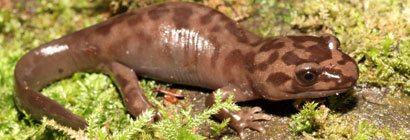 |
| Small Adult, Santa Clara County |
Juvenile, Marin County |
 |
 |
 |
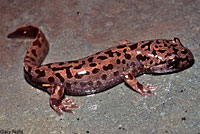 |
| Small adult, Santa Clara County (about 3.5 inches svl) |
Small adult, Santa Cruz County |
 |
 |
 |
 |
| Juvenile, Sonoma County (3 inches svl) |
Small adult, Santa Cruz County |
Small adult, Santa Cruz County |
 |
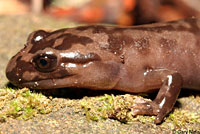 |
 |
 |
| Juvenile, Marin County (2 inches svl) |
Adult, Sonoma County (about 4 inches svl) |
 |
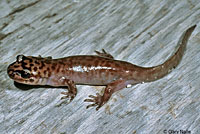 |
 |
 |
| Sub-adult, Santa Cruz County |
Adult, San Mateo County © Mark Gary |
Adult, found in shallow water in daylight, Santa Cruz County. © Scott Peden |
 |
 |
 |
 |
Adult, San Mateo County
© Melissa Amarello |
Adult, found on a rock on an October afternoon in Marin County.
© William Mays |
9-inch adult moving on a November afternoon, Santa Cruz County.
© Scott Peden |
Juvenile, Sonoma County © Lou Silva |
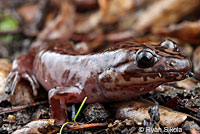 |
 |
 |
 |
| Young adult, Santa Cruz County showing the characteristic marbling on the chin and throat. © Ryan Sikola |
Sub-adult, Marin County
© Randolph K Thomas |
 |
 |
 |
 |
| Adult, Marin County © Randolph K Thomas |
Adult, Sonoma County |
 |
 |
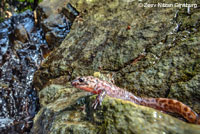 |
|
| Adult, Santa Cruz County © Becca Morn |
Large adult, (a little over 11 inches in total length and nearly 6 inches svl) Marin County. © Tim Burkhardt |
Adult, Santa Cruz County
© Zeev Nitzan Ginsburg |
|
 |
 |
|
|
Small adult California Giant Salamander, Santa Clara County
A
comparison of the sizes of the smallest genus of salamander in California (Batrachoseps) - California Slender Salamander - on bottom, with the largest genus of salamander in California (Dicamptodon) - on top. |
Sonoma County adults
A
comparison of the sizes of a California Slender Salamander - on hand with a California Giant Salamander, on bottom. |
|
|
| |
|
|
|
Unusual California Giant Salamanders |
 |
 |
 |
 |
This terrestrial adult with an unusual "obese" appearance was found in a pool in a creek in San Mateo County in mid July. (According to salamander experts who have seen these pictures, this condition may be
an extensive subcutaneous edema caused by an infection or from failure, also known as dropsy, or water retention. Or it might be caused by an oxygen consumption problem.
© Jaeda Chin |
This terrestrial adult, found in water in Spring in southern Santa Cruz County, shows a similar abnormal appearance to the salamander in the photos to the left.
© Barry Sinervo |
 |
 |
 |
|
Unusually "warty" neotenic adult (about 7 inches in length) found in a stream in Santa Cruz County. © Ian Gaston
This condition is likely the result of an infection caused by a parasite. A similar "warty" condition has been found in California Newts found in San Diego County. That condition was also determined to be from disease. "Warty" newts have also been reported on the San Francisco Peninsula. |
This is a smaller less-warty aquatic salamander from the same area in Santa Cruz County as the one to the left.
© Ian Gaston |
This Marin County adult salamander has a "warty" appearance that could be a potential trematode infection.
© Andre Giraldi |
|
| |
|
|
|
| Aquatic Larvae and Neotenic Adults |
 |
|
| Neotenic adult, Marin County © Terry Goyan |
|
 |
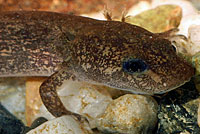 |
 |
 |
| Very small aquatic larva in water, Sonoma County |
 |
 |
 |
 |
| Neotenic adult about 4.5 inches snout-to-vent, Marin County © Andre Giraldi |
Aquatic larva, Santa Cruz County
© Kamil Szepanski (lungenlos.de) |
Aquatic larvae, (about 5 inches long or 130 mm) Santa Cruz County
© Kamil Szepanski (lungenlos.de)
Kamil Szepanski photographed these larvae in the creek just outside the cave in Santa Cruz where a population of patternless gray paedomorphs have been found, and he thinks these may have drifted out of the cave since they were similarly gray and patternless.
|
| |
|
|
|
| Giant Salamanders Feeding |
 |
 |
 |
 |
This juvenile or sub-adult was found eating a Banana Slug in the mountains of San Mateo County in mid December
© Abby Edwards |
Suzanne Cogen found this adult eating a Banana Slug at 3 PM in mid December in Sonoma County.
© Suzanne Cogen |
 |
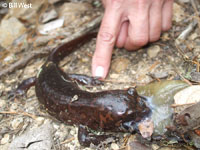 |
 |
 |
| This California Giant Salamander was found on a hiking trail in Marin County on a foggy mid May afternoon wet with fog drip. It was observed for about 20 minutes as it slowly attempt to eat the banana slug. Banana slugs are very sticky and their slime causes numbness, which makes it difficult to swallow them. © Bill West |
 |
 |
 |
 |
| Max Kelley found this adult eating a large rodent, possibly a Wood Rat, one late November day in San Mateo County. In this picture, only the rodent's long tail is still visible. © Max Kelley |
Nancy Gribler discovered this large adult eating a Banana Slug one night in her Marin County back yard.
© Nancy Gribler |
Sub-adult eating a Banana Slug in San Mateo County © Zach Lim |
| |
| Habitat |
 |
 |
 |
 |
Habitat, San Mateo County
|
Habitat, Sonoma County |
Habitat, Marin County |
Habitat, Sonoma County |
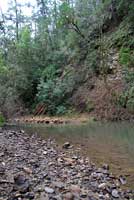 |
 |
 |
|
| Habitat, Santa Clara County |
Habitat, Santa Clara County
|
Habitat, Sonoma County |
|
| |
|
|
|
Sounds and Videos |
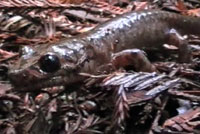 |
 |
 |
 |
| A short video of a juvenile California Giant Salamander in the Redwoods. |

After discovering this small adult hiding under a small fallen log in the Sonoma County redwoods, Jeff Rice and I set up our recorder and aimed our microphone. Then I gently picked it up with my thumb and two fingers grasping the sides of its body, firmly, but without squeezing so hard I was merely pushing air out of its lungs. The salamander squirmed from side to side and opened its mouth slightly. After about 10 seconds it made the chirping sound that you can hear here. That's all we were able to get...
This species is capable of making a fairly loud sound, but this one was very quiet, so there is a lot of background noise from a running creek nearby.
|
This short video shows some of the sounds this salamander is capable of making.
A hiker in mid February observed this huge adult CA Giant Salamander walking on a dirt trail at 1 PM in Santa Cruz County. He had no idea what it was when he got close with his video camera, and was startled to hear a loud rattling bark - and the camera movement shows it. You can just barely see the salamander opening its mouth as it produces this first roar. Then we can hear the salamander making some more raspy rattling sounds as it stands in a defensive posture. After using this site to identify the huge mysterious rattling beast he saw in the forest, he sent me the video so that we can all admire this salamander's performance.
|
This is the sound of a juvenile California Giant Salamander in Sonoma County making noises while trying to crawl under leaf litter after being uncovered.
There is noise of rustling leaves, but
you can hear the salamander start off immediately with some clicks, followed by a louder chirp and then a more drawn out growl.
© Elliott Smeds |
| |
|
|
|
|
|
|
|
| Description |
| |
| Size |
Adults are 2 1/2 to 6 4/5 inches long (6.25 - 17 cm) from snout to vent, 6.7 - 12 inches (17 - 30.5 cm) in total length.
|
| Appearance |
One of the largest terrestrial salamanders in North America, with a large robust body, a massive head, and stout limbs.
Transformed adults have 12 - 13 indistinct costal grooves.
The tail is flattened from side to side to facilitate swimming.
Larvae are stream-type with tail fins that extend forward only to the hind limbs.
There is often heavy black mottling.
Gills are short, bushy, and dull red. |
| Color and Pattern |
Light reddish brown coloring above is overlaid with copper-colored marbling that gives the salamander a camouflaged appearance.
The venter is whitish or dull yellow, usually unmarked.
|
| Comparison With Coastal Giant Salamander |
Dicamptodon tenebrosus, Coastal Giant Salamander, is very similar in appearance to D. ensatus.
As far as I can determine, the only field mark that is useful to tell one species from the other is the presence of marbling on the chin and throat of D. ensatus, which is absent on D. tenebrosus, and possibly the underside, which is whitish on D. ensatus and gray to tan on D. tenebrosus.
According to Stebbins & McGinnis 2012, both species are similar in body length but D. tenebrosus has a
smaller head, shorter limbs, fewer teeth in the uper jaw, a darker body color both dorsally and ventrally, and the marbling pattern tends to be finer.
Stebbins, 2003, says that the "dark marbling and flecking usually does not extend onto underside of throat and limbs" and that there are "dark flecks and blotches on throat and underside of legs" of D. ensatus and that "Marbling on chin notable in southern part of range."
Fellers and Kuchta in Amphibians of the Pacific Northwest, 2005 state it this way:
On D. ensatus:
"Marbling or blotching on lower jaw often extends onto the chin, throat and underside of the forelimbs and pectoral girdle."
On D. tenebrosus:
"Adult Coastal Giant Salamanders do not have marbling that extends beyond the lower jaw onto the chin or throat.
|
| Life History and Behavior |
A member of family Dicamptodontidae - Giant Salamanders, and the genus Dicamptodon - Pacific Giant Salamanders, whose members are large in size with heavy, stocky bodies.
Dicamptodon have two distinct life phases:
- Larvae are born in the water where they swim using an enlarged tail fin and breathe with filamentous external gills.
- Aquatic larvae transform into four-legged salamanders that live on the ground and breathe air with lungs.
Neotenic adults which retain their gills and continue to live in water are found in many populations.
These gilled adults may outnumber transformed individuals.
In Bruce Bury's account of the species in Lanoo, 2005, as shown on AmphibiaWeb, he cites two sources that report that "In related Pacific giant salamanders, newly metamorphosed juveniles (Nussbaum et al.,1983) and sometimes neotenic adults (Welsh, 1986) move away from streams in rainy periods." |
| Activity |
Little is known about the natural history of D. ensatus, much of which is presumed from studies of the similar species D. tenebrosus.
This salamander is nocturnal, but also active in daylight during wet conditions.
Adults are typically found within 50 meters of streams.
Terrestrial adults often remain in underground retreats, emerging to forage on the forest floor on rainy nights and during daylight in wet periods in winter.
They are sometimes seen walking on forest trails in daylight and on paved roads near streams on rainy nights, especially during the first heavy Fall rains in November and December. Adults are also found under rocks in streams and under objects on the ground that retain moisture such as rocks, logs, and artificial cover objects.
Post-metamorphs sometimes return to streams when terrestrial conditions become hot and dry.
|
| Sound |
This salamander often produces a vocal sound when threatened, which is a low rattling bark-like sound.
According to Stebbins and Cohen, 1997, the Coastal Giant Salamander has "...vocal cords and can bark or rattle. Its sounds are thought to startle predators."
You can hear some more examples of these sounds above. |
| Defense |
| Large adults are capable of delivering a painful bite. |
| Diet and Feeding |
Presumably, the diet consists of anything small enough for a salamander to overpower and eat, including slugs and other invertebrates, and small vertebrates such as salamanders, small rodents, and lizards. Eggs or embryos have been found in large larvae and terrestrial adult giant salamanders.
Giant salamanders are sit-and-wait predators. When prey comes near they lunge quickly to grab the prey with their mouth and crush it with their jaws.
Aquatic larvae probably have a similar diet to the larvae of Dicamptodon tenebrosus, which consists of small aquatic invertebrates and small fish hatchlings. |
| Reproduction |
According to Petranka, 1998, regarding Dicamptodon ensatus: "Information on the mating season and courtship behavior is not available."
The information here regarding breeding, eggs, and young, is mostly taken from our account of the similar species Dicamptodon tenebrosus.
Reproduction is aquatic. Fertilization is internal.
Females reach sexual maturity in 5 to 6 years.
Mating occurs mostly in spring, usually in May, but later in the hear at high elevations. Breeding may also occur in the Fall.
Males and females move from their hiding places on land to a stream where they fertilize and lay eggs.
According to Nussbaum et al, 1983, observations of Dicamptodon in captivity and in the field suggests that courtship takes place in "hidden water-filled nest chambers beneath logs and stones or in crevices.
Males deposit up to 16 spermatophores.... Females pick up one to a few of the sperm caps with their cloacas and deposit their entire clutch of 135 to 200 eggs (larger females deposit more eggs) in the nest chamber. The eggs are attached singly, side-by-side, usually on the roof of the nest chamber."
Only a few nest sites have been observed in the wild.
The female stays with the eggs to guard them until they hatch. At the southern end of their range that is typically in January and February.
A female probably does not breed more than once every two or more years because of the long time she spends with her eggs.
"The function of maternal care is not fully understood, but prevention of egg cannibalism seems to be one function." Eggs or embryos have been found in the stomachs of large larvae and terrestrial adult giant salamanders which indicates that they are a threat to a nest site. |
| Larvae and Young |
Larvae hatch in water and transform to a terrestrial form in probably about 18 - 24 months after hatching, depending on environmental conditions and the size and permanence of the stream.
Larvae live on their yolk for 3-4 months after hatching then they feed on invertebrate prey and small amphibian larvae.
Some larvae may overwinter and transform in their third year.
Young larvae are found in still water near the shoreline, often under small rocks and leaf litter.
Older larvae are found in the main stream channel.
Larvae are more abundant than transformed adults.
Larvae can be found exposed in the water at the edge of a stream at night by shining a light at the water.
Recently metamorphosed juveniles move out of streams to the surrounding habitat during wet periods.
|
| Young |
Larvae hatch in water and transform to a terrestrial form in probably about 18 - 24 months after hatching, depending on environmental conditions and the size and permanence of the stream.
Larvae live on their yolk for 3-4 months after hatching then they feed on invertebrate prey and small amphibian larvae.
Some larvae may overwinter and transform in their third year.
Young larvae are found in still water near the shoreline, often under small rocks and leaf litter.
Older larvae are found in the main stream channel.
Larvae are more abundant than transformed adults.
Larvae can be found exposed in the water at the edge of a stream at night by shining a light at the water.
Recently metamorphosed juveniles move out of streams to the surrounding habitat during wet periods.
|
| Habitat |
Occurs in wet coastal forests in or near clear, cold permanent and semi-permanent streams and seepages.
One population has been found inhabiting flowing water in a network of caves.
|
| Geographical Range |
Endemic to California, found in two, possibly three isolated regions, from Mendocino County near Point Arena east into the coast rages into Lake and Glenn counties, south to Sonoma and Marin counties, continuing south of the San Francisco Bay from San Mateo County to southern Santa Cruz county.
Does not occur east of the San Francisco Bay.
There is a sight record for the species from the Little Sur River in Monterey County that needs confirmation. (Stebbins, 2003, McGinnis & Stebbins, 2018). |
| Elevational Range |
Occurs from sea level to near 3,000 ft.
|
| Notes on Taxonomy |
In 1989 the species Dicamptodon ensatus, was split into 3 species when evidence showed that Dicamptodon from Sonoma County south were genetically distinct from those to the north and from Dicamptodon in Idaho and Montana.
The southern species became Dicamptodon ensatus - California Giant Salamander.
The northern species became Dicamptodon tenebrosus - Coastal Giant Salamander.
The eastern species became Dicamptodon aterrimus - Idaho Giant Salamander.
The fourth species of Dicamptodon, Dicamptodon copei - Cope's Giant Salamander, was not changed.
Discovery of three lineages of California Giant Salamander
A DNA study published in 2021 revealed 3 major lineages or distinct population segments of D. ensatus with little contact and little gene flow between them. These lineages conform to the two isolated north/south regions shown on the current distribution map, with a northern lineage, a southern lineage, with an additional third lineage found in a very small region of the Marin Hills at the southernmost edge of the northern region. (The northern lineage is made up of two distinct clades and further research could show that they are 2 different lineages.) Phylogeography can be used to explain the development of the 3 lineages as they are "...bounded by 4 major current or past geological features; the North Coast Divide, the former Wilson Grove Embayment/current Petaluma Gap, San Francisco Bay, and Monterey Bay."
The authors do not make any taxonomic recommendations pending further molecular examination that could determine if the three lineages are discrete populations or could be thought of as subspecies.
[Brian R. Lavin, Briana S. Callahan, Regan A. Connell, & Derek J. Girman. Phylogeography and Genetic Structure in the California Giant Salamander (Dicamptodon ensatus): Impacts of current and historic landscape features. Zootaxa 5068 (1): 060–080 Copyright © 2021 Magnolia Press]
Alternate and Previous Names (Synonyms)
Dicamptodon ensatus - California Giant Salamander (Stebbins 2003, 2012)
Dicamptodon ensatus - Pacific Giant Salamander (Bishop 1943, Stebbins 1954, 1966, 1985)
Dicamptodon ensatus - Marbled Salamander (Storer 1925)
Ambystoma ensatum (Dunn 1920)
Ambystoma tenebrosum (Stejneger and Barbour 1917)
Ambystoma ensatum - Marbled Salamander - Oregon Salamander (Chondrotus tenebrosus; Amblystoma tenebrosum; Dicamptodon ensatus; Xiphnura tenebrosa; Chondrotus lugubris) (Grinnell and Camp 1917)
Triton ensatum (Van Denburgh 1916)
Dicamptodon ensatus (Strauch 1870)
Xiphonura tenebrosa (Girard 1858)
Amblystoma tenebrosum (Cope 1867)
Triton ensatus (Eschscholtz 1833)
|
Santa Cruz Cave Salamander
UC Santa Cruz biologist Barry Sinervo has discovered and studied a paedomorphic form of California Giant Salamander that is found in a system of caves in Santa Cruz County. These aquatic salamanders are all patternless and grey in coloration, possibly from consuming food in the cave that has no pigment. (A cave salamander fed pigmented food in the laboratory became darker in color.) Sinervo and his students collected larval salamanders from inside the cave and just outside the cave, then raised them in captivity. The cave salamanders stayed in the aquatic phase while 19 of 20 salamanders from outside the cave transformed into the terrestrial phase. (Cope's Giant Salamander - Dicamptodon copei, is a similar species that is also fixed on the paedomorphic form.)
In a letter dated January 2006, Sinervo says that it is likely that these salamanders represent a genetically distinct population segment that is different from surface populations just outside the cave. He needs to analyze the DNA of more salamanders in order to determine how distinct they are, but due to the drought present before 2016 which caused no water to flow into the caves, specimens have not been available. Protecting the unique environment in the caves should be a priority until the lineage of the salamanders can be determined.
Articles about this population have been published in a number of Santa Cruz news sources, including the Santa Cruz Sentinel in 2006, the Daily Breeze 3/7/16, and the Hilltromper Santa Cruz 1/21/16: http://hilltromper.com/article/new-species-giant-salamander-living-under-ucsc
but none has published a picture of one of the salamanders.
|
| Conservation Issues (Conservation Status) |
There is not much evidence to show that the current distribution of this species is different from the historical distribution, however extensive habitat alteration in its range has most likely destroyed some populations. Forest removal and road building near streams has reduced the number of larvae of the similar species Dicamptodon tenebrosus, while opening of the forest canopy over streams may also be temporarily beneficial to the larvae.
Protected from take with a sport fishing license in 2013. |
|
| Taxonomy |
| Family |
Dicamptodontidae |
Giant Salamanders |
Tihen, 1958 |
| Genus |
Dicamptodon |
Pacific Giant Salamanders |
Strauch, 1870 |
Species
|
ensatus |
California Giant Salamander |
(Eschscholtz, 1833) |
|
Original Description |
Eschscholtz, 1833 - Zool. Atlas, Pt. 5, p. 6, pl. 22
from Original Description Citations for the Reptiles and Amphibians of North America © Ellin Beltz
|
|
Meaning of the Scientific Name |
Dicamptodon - Greek = two curved, bent teeth, referring to doubly curved teeth
ensatus - Latin = sword-shaped, possibly referring to the pointed teeth.
from Scientific and Common Names of the Reptiles and Amphibians of North America - Explained © Ellin Beltz
|
|
Related California Salamanders |
Coastal Giant Salamander
|
|
More Information and References |
California Department of Fish and Wildlife
AmphibiaWeb
Hansen, Robert W. and Shedd, Jackson D. California Amphibians and Reptiles. (Princeton Field Guides.) Princeton University Press, 2025.
Stebbins, Robert C., and McGinnis, Samuel M. Field Guide to Amphibians and Reptiles of California: Revised Edition (California Natural History Guides) University of California Press, 2012.
Stebbins, Robert C. California Amphibians and Reptiles. The University of California Press, 1972.
Flaxington, William C. Amphibians and Reptiles of California: Field Observations, Distribution, and Natural History. Fieldnotes Press, Anaheim, California, 2021.
Nicholson, K. E. (ed.). 2025. Scientific and Standard English Names of Amphibians and Reptiles of North America North of Mexico, with Comments Regarding Confidence in Our Understanding. Ninth Edition. Society for the Study of Amphibians and Reptiles. [SSAR] 87pp.
Samuel M. McGinnis and Robert C. Stebbins. Peterson Field Guide to Western Reptiles & Amphibians. 4th Edition. Houghton Mifflin Harcourt Publishing Company, 2018.
Stebbins, Robert C. A Field Guide to Western Reptiles and Amphibians. 3rd Edition. Houghton Mifflin Company, 2003.
Behler, John L., and F. Wayne King. The Audubon Society Field Guide to North American Reptiles and Amphibians. Alfred A. Knopf, 1992.
Robert Powell, Roger Conant, and Joseph T. Collins. Peterson Field Guide to Reptiles and Amphibians of Eastern and Central North America. Fourth Edition. Houghton Mifflin Harcourt, 2016.
Powell, Robert., Joseph T. Collins, and Errol D. Hooper Jr. A Key to Amphibians and Reptiles of the Continental United States and Canada. The University Press of Kansas, 1998.
American Museum of Natural History - Amphibian Species of the World 6.2
Bartlett, R. D. & Patricia P. Bartlett. Guide and Reference to the Amphibians of Western North America (North of Mexico) and Hawaii. University Press of Florida, 2009.
Bishop, Sherman C. Handbook of Salamanders. Cornell University Press, 1943.
Lannoo, Michael (Editor). Amphibian Declines: The Conservation Status of United States Species. University of California Press, June 2005.
Petranka, James W. Salamanders of the United States and Canada. Smithsonian Institution, 1998.
Jones, Lawrence L. C. , William P. Leonard, Deanna H. Olson, editors. Amphibians of the Pacific Northwest. Seattle Audubon Society, 2005.
Stebbins, Robert C. and Nathan W. Cohen. A Natural History of Amphibians. Princeton University Press, 1997.
Joseph Grinnell and Charles Lewis Camp. A Distributional List of the Amphibians and Reptiles of California. University of California Publications in Zoology Vol. 17, No. 10, pp. 127-208. July 11, 1917.
Brian R. Lavin, Briana S. Callahan, Regan A. Connell, & Derek J. Girman.
Phylogeography and Genetic Structure in the California Giant Salamander (Dicamptodon ensatus): Impacts of current and historic landscape features.
Zootaxa 5068 (1): 060–080 Copyright © 2021 Magnolia Press
https://doi.org/10.11646/zootaxa.5068.1.2
|
|
|
The following conservation status listings for this animal are taken from the July 2025 State of California Special Animals List and the July 2025 Federally Listed Endangered and Threatened Animals of California list (unless indicated otherwise below.) Both lists are produced by multiple agencies every year, and sometimes more than once per year, so the conservation status listing information found below might not be from the most recent lists, but they don't change a great deal from year to year.. To make sure you are seeing the most recent listings, go to this California Department of Fish and Wildlife web page where you can search for and download both lists:
https://www.wildlife.ca.gov/Data/CNDDB/Plants-and-Animals.
A detailed explanation of the meaning of the status listing symbols can be found at the beginning of the two lists. For quick reference, I have included them on my Special Status Information page.
If no status is listed here, the animal is not included on either list. This most likely indicates that there are no serious conservation concerns for the animal. To find out more about an animal's status you can also go to the NatureServe and IUCN websites to check their rankings.
Check the current California Department of Fish and Wildlife sport fishing regulations to find out if this animal can be legally pursued and handled or collected with possession of a current fishing license. You can also look at the summary of the sport fishing regulations as they apply only to reptiles and amphibians that has been made for this website.
|
| Organization |
Status Listing |
Notes |
| NatureServe Global Ranking |
G2G3 |
Imperiled - Vulnerable |
| NatureServe State Ranking |
S2S3 |
Imperiled - Vulnerable |
| U.S. Endangered Species Act (ESA) |
None |
|
| California Endangered Species Act (CESA) |
None |
|
| California Department of Fish and Wildlife |
SSC |
California Species of Special Concern |
| Bureau of Land Management |
None |
|
| USDA Forest Service |
None |
|
| IUCN |
NT |
Near Threatened |
|
|
|
 Red: Range in California
Red: Range in California










































































